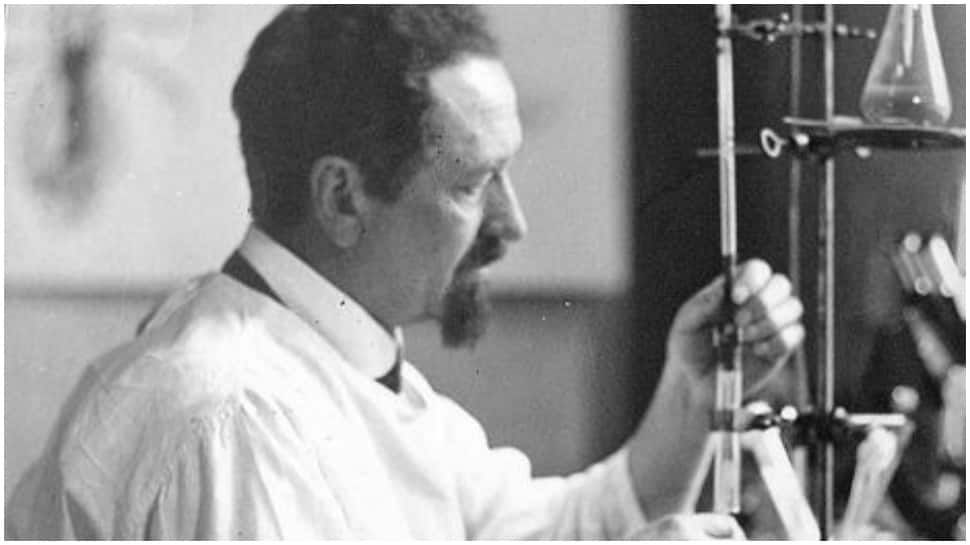A German scientist working to develop a vaccine against typhus saved thousands of Jewish people during World War II. Dr. Rudolf Weigl developed the first effective vaccine against typhus. His efforts helped prevent the spread of typhus among the millions of refugees fleeing Nazi Germany.
Rudolf Weigl was born in Königsberg, East Prussia, into a family of physicians. After graduating from medical school in 1906 he served his internship at the hospital in Würzburg. In 1909 he became a specialist in internal medicine and infectious diseases at the University of Freiburg. There, he began work on a project to develop a vaccine against plague. This research led him to develop a method of treating patients infected with bubonic plague.
In 1914 Weigl moved to Berlin, where he set up a small laboratory to continue his work on plague vaccines. He joined the army in 1915, serving as a doctor in the field hospitals of the Eastern Front. While there, he continued his work on plague vaccines, and discovered that the disease could be transmitted via lice. By 1917 he had begun testing his vaccine on humans.

Life
Weigl was born in Preráu, now known as Przemyśl in Poland, then part of Austria-Hungary, to Viennese Jewish parents. His father, Joseph Weigl, worked as a pharmacist while his mother, Helene née Hirsch, was a housewife. He grew up in Lviv, then part of the Austrian province of Galicia. At age 13 he began studying medicine at the local university. In 1907, at the age of 22, he received his doctorate degree.
He married Helena “Helen” Nusbaum (1876–1958) in 1908; she was a native of Vienna and daughter of Rabbi Dr. Sigmund Nusbaum. They lived together in Paris, France, where Weigl taught biology at the Sorbonne. Their son, Heinrich Weigl Jr., was born in 1910. Their second son, Hans Weigl, was born in 1912.
In 1914, during World War I, the couple returned to Vienna, where Weigl joined the army medical corps. He was wounded twice, once seriously enough to cause him to lose his left eye. During the war, Weigl met another physician, Dr. Maximilian Wieland (1881–1945), who later became his lifelong friend.
After the end of the war, Weigl resumed teaching at the university in Lviv, where he remained until 1922, when he accepted a professorship at the newly founded Jagiellonian University in Krakow, Poland. There he continued his research on the causes of cancer.
During the early 1920s, Weigl published several papers about the treatment of tuberculosis. In 1923, he became a professor at the University of Vienna, where he stayed until 1931.
At the same time, Weigl took an interest in politics. He supported the liberal political party, the Social Democratic Party of Austria, and served as vice president of the Austrian Association of Physicians. In 1924, he married his third wife, Erika von Schönborn.
In 1926, Weigl wrote a book titled Cancer and Its Treatment, which was translated into English in 1928.
Vaccine development
In 1930, following Charles Nicollet’s 1909 discovery that louse are the vector of epidemic typhoid fever, and following the work carried out on a vaccine for the similarly named Rocky Mountain spotted fever, weigl took the next step and produced a typhus vaccine by culturing infected lice and grinding them up into a vaccine paste. This vaccine proved successful in clinical trials against typhus and was licensed by the US government in 1934.
Weigl’s initial experiments used lice cultured from patients with epidemic typhus. However, it soon became clear that the same methods could be applied to culture the bacterium itself and thus develop a vaccine against it. Weigl experimented with different strains of the bacterium and found one strain, R. prowazekii, was particularly suitable for his purposes.
He established a laboratory where he could grow large numbers of lice and inject them with live R. prowazeki. His main concern was to prevent infection of the lice rather than killing them outright. To do this, he injected the lice with a type of virus called “typhus”, which attacks the gut lining of the insect and prevents it from absorbing nutrients.
His method involved injecting the lice with a small amount of typhus, allowing the insects to feed normally for several days, and then repeating the process again. By doing this, he ensured that each individual louse had been exposed to enough typhus to make it susceptible to the disease, while still being able to feed normally.
After the lice had fed and rested for several days, Weigl ground them up into a fine powder and mixed the resulting material together with saline solution. This mixture was then inoculated into rabbits, guinea pigs and finally human volunteers.
Although the first trial showed some success, Weigl needed to improve upon the vaccine in order to scale up production. An important aspect of his research was the use of a micro-injection technique to deliver the vaccine to the lice. Using this approach, he was able to inoculate thousands of lice at once and thereby increase the number of animals that received the vaccine.
In 1933, Weigl published a paper describing his method for producing a vaccine against typhus. He described how he grew healthy lice, injected them with live typhus, allowed them to feed normally for several weeks, and then crushed the lice up into a vaccine paste for injection into animals.
Later years, death, and legacy
Weigl’s research into typhoid fever led him to develop a vaccine against it. His work earned him international recognition, and he received many awards. In 1935, he became a member of the Royal Academy of Sciences in London. During World War II, he worked tirelessly to produce a safe vaccine for soldiers fighting in the trenches of France and Belgium.
After the war, Weigl returned to university life, becoming professor of microbiology at the Jagiellonian University in Kraków. He joined the Communist Party in 1949, and was elected to the Sejm (parliament) in 1952. However, his political views caused friction among members of the party, and he was forced to resign in 1955. A few months later, he died in a hospital near Kraków.
The city of Weigl, located in southwestern Poland, is named after him.
Awards and honors
Nobel laureates
Weigl was continually nominated for a Nobel Prize throughout the 1930s and 1940s. He was considered one of the most promising candidates for the prize since 1903. However, he did not receive a single nomination for the prize until 1934. Between 1935 and 1939, Weigl was nominated four times. During this period, he was awarded the Max Planck Medal twice and the Otto Hahn Peace Prize once.
In 1937, Weigl was awarded the Lasker Award for Clinical Research. He was also appointed honorary member of the German Academy of Sciences Leopoldina in 1938. In addition, he was elected president of the International Health Board in Geneva.
The following year, Weigl was nominated for the Nobel Prize five times. In total, he was nominated six times. In 1941, he was nominated again and became the second person to ever be nominated multiple times without winning.
Righteous among nations
On 12 January 2004, Weigl was honoured as Righteous Among the Nation by the Israeli government. Weigl had saved thousands of Jews during the Holocaust by providing them with safe places where they could hide from Nazi persecution. As such, Weigl was awarded with the title “Righteous Among the Nations”.
Google doodle
Rudolf Weigl’s 138th Birthday
In 1883, Dr. Rudolf Weigl was born in Przerów, Austria-Hungary. He studied biology at Lviv University and joined the army as a bacteriologist. In 1914 he began working on his greatest accomplishment—a vaccine against typhus. By 1918, he had developed a successful vaccine that protected soldiers from the disease. For his work, he received the Order of Polonia Restituta, the highest award given by the government of Poland.





